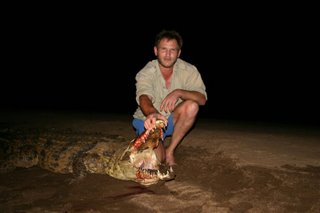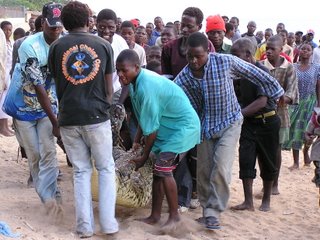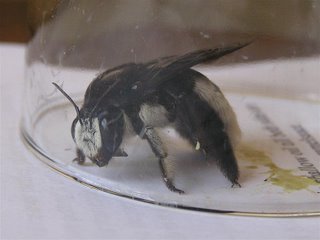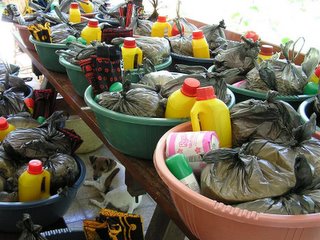As an endangered species, there aren’t too many places in the world where crocodiles can be legally hunted. Malawi is one of those places due to its large stretch of lakeshore that is densely populated with both crocs and people. As a signatory of the Convention on the International Trade of Endangered Species (CITES), Malawi issues 20 highly sought after licenses annually. These licenses split the lakeshore of Malawi’s great lake into roughly even concessions where hunters can collect 20 crocs each. The hunters are issued with CITES tags for their trophies which allow them to trade the skins of the beasts they kill on the international market.
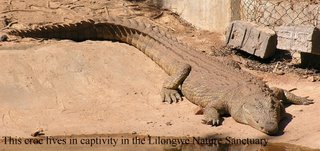
Internationally, crocodile skin can command fairly high prices although most of the skins that feed the world’s demand for purses, shoes, wallets and belts come from croc farms. Only the skin of the crocodile’s belly is harvested and traded. The skin is sold by the usable inch of flesh. In fact, wild crocodile skins are usually less valuable than their farmed cousins’ due to the latter’s regulated and sheltered lives and therefore less scarred bellies. Malawi has at least one croc farm that does a very lucrative business. Here, hunting crocodiles is considered a sport and a service to the rural communities that are saved from monsters that prey on people and livestock as well as compete with fishermen for sustenance. Hunting crocs is not a for profit exercise due to the expense of either hiring or owning and maintaining a boat that can take the hunter into croc territory and the low-ish odds of finding and killing a beast in the course of any given sortie.
This reporter’s short study has yielded the observation that writing on hunters and hunting comes in two distinct varieties with little or nothing in between. Hunters write about their successful hunts and the adventure, techniques and tools that led to success in their fields. Anti-hunting campaigners write about their disgust with the blood sport, the irresponsibility of (some) hunters and the danger to people and environments caused by hunters running around with guns, not to mention snares and other assorted traps. This is not the place to get into the debates on a global scale. It is a given that in any human undertaking there are those that go about it in an ill-informed, unprincipled, dangerous and/or selfish manner. It is also a given that human communities, especially rural ones, compete for space and resources with animals, their habits and habitats on a bloody day to day basis that leaves many urban citizens a little cold.
The experience of two recent weekends hunting has occasioned some interesting personal reflection on the debates. I hereby share the stories. I’ll put any growing queasiness to rest by stating now that no crocodiles died to bring you this story. A little known fact among non-hunters is that the odds are apparently about even that a hunter might discharge their gun in the direction of dangerous game on any given hunting sortie. Apparently, the appallingly low odds that something might actually be killed are an important motivator for otherwise comfort loving individuals to subject themselves to the discomforts and hazards of hunting big game.
Two weekends ago we were at the lake with the stated purpose of hunting crocs. Two friends joined us at our favourite lodge in Senga Bay about an hour’s drive from Lilongwe. They were hoping to join the expedition to root out monsters. Unfortunately, we didn’t even make it out on to the lake. Windy conditions throughout the weekend made the water too rough for accurate target acquisition from a boat. Instead, we visited a hippo and bird sanctuary and watched rugby on satellite TV.
So far so good. On the earlier hunting trip to the same lodge but with another couple, we did make it out onto calm night waters with two guns in the boat. I have learned of two methods of hunting crocodiles. If night hunting is ruled out as impossible, unsuccessful, or otherwise illegal, crocs are enticed into the rage of a hunter’s gun with the dripping remains of a recently killed animal hung over the water as bait. The hunter(s) wait under natural or duly constructed cover for their prey to investigate and feed on the bloody offering with obvious results. In Malawi, the accepted, less labour intensive and most popular method of croc murder is night hunting with a spotlight.
For the purposes of this expedition, the four of us headed out on the boat with a local guide during the day to scope out possible places where the beasts might be lurking. The guide took us into a strip of lakeshore where reeds and assorted water grasses formed a delta-like area of inlets and shallow waters. These form excellent fishing grounds for crocs and people alike. A short visit to a fishing camp revealed the information that indeed, there be monsters in those waters. One had killed a person only three months earlier. We spent some time motoring around the area, taking waypoints on a global positioning system unit and generally enjoying the beautiful environment. Apparently, the area used to be known for its phenomenal sport fishing. The sheer number of local fishermen on the water trolling for their living was ample evidence that this was probably no longer the case. The sight of the men standing in their dugouts swinging their circular nets over their heads like a lasso before flinging them into the water was picturesque if not encouraging. However, the profusion of water birds that prey on fish such as cormorants plus a beautiful pair of nesting fish eagles (pictured here) were a welcome sight. The clear water and warm sun enticed one hunter cum fisherman to try his hand with his fly fishing rod with no luck.

I returned with the hunters to the same spot well after dark. Having talked me into agreeing to be the “spotter” for their night’s hunting, they were able to dismiss the guide. I was reluctant to go due to the rough ride that we had had earlier and the other hunter’s wife’s refusal to accompany them. I did not have the excuse of pregnancy at my disposal and her encouragement that it was truly an adventure not to be missed won me over. It was a beautiful night. The water had calmed to a glassy surface that reflected the almost full moon beautifully. I learned to sweep the beam of light from the powerful spotlight across the surface of the water and to pick out the telltale red reflection from a crocodile’s eye hanging along the edge of the water where the grasses grew. Due to the need for activity by the hunter who was not the skipper of the boat, I was quickly demoted from spotlighter to gun bearer. In the end, I did not consider this a demotion given the challenges of trying to keep a loaded rifle out of the way of the hunters and the puddles in the boat while we quietly motored and drifted.
We spent the better part of two hours thus. We spotted, stalked and eventually came upon at least a dozen very young crocodiles that were all between 30-50cm in length. They were beautiful little things that were obviously too small to be considered fair game. It is amazing that their tiny eyes could be spotted and kept in our sights from at least a couple hundred meters. At one point, our companion hunter reached into the water and demonstrated beautiful croc capture technique, grabbing an unsuspecting creature just behind its head. We all marveled at its perfect little body and amazing strength as it thrashed in an effort to force its release. Of course it was released in due course and jack-knifed sharply as soon as the hunter let go in an attempt to snap at his hand in the air.
The larger size of the red dot combined with its distance from the comparative safety of the shore got the hunters really excited. The motor was cut and we drifted towards the beast. I tried to calm my panicked breathing as I quietly traded the gun for the light. The hunter steadied himself to shoot from the bow of the boat. I stood at his shoulder with the light, apprehensively wondering if the blast of the shotgun would knock me right into the water and if the thrashing of the beast would capsize us anyway. From my vantage, it was easily as long as the boat. We all saw and appreciated the size of the snout (and therefore the rest) of the monster before it dove and disappeared only to reappear as a distant red dot again before disappearing for good. We returned to the area several times, spotting the same beast and maybe a second smaller one from afar and coming within a few tens of meters each time but the bright moon was both a blessing and a curse as it lighted both our expedition and the beast’s escape.
As we quietly motored along the line of reeds where they met the water we were increasingly alarmed that most of this shoreline was covered by small gauge netting that hangs from the surface of the water to the shallow bottom about 1-3meters down. This is designed to catch everything that swims out of the reeds, including small crocodiles that keep to the edges of the reed beds for protection. This might explain the profusion of small crocs, the spotting of at least one and perhaps two monsters but nothing in between. This seeming unnaturally large generation gap can be explained by the admitted practice of the fishermen to kill small crocs that get caught in their nets thereby eliminating potential competitors before they become killers. It appears that the monsters have made their home there for some time but their attempts to reproduce are being frustrated by the fishing practices of the human communities in the area.
The fishermen complain of ever smaller catches in volume and size and quite obviously barely eke out an existence with their work. One might observe that state of the national highways and cost and availability of transport to move catches actually works in favour of the lake’s biodiversity but there’s no lack of piles of small fish in the cities’ markets. It appears that these methods are also much more effective in eliminating dangerous crocs from the lakeshore than the hunters’ expeditions will over the long term.

This is a shot of an average lakeshore fishing village in Senga Bay. Long tables are set up to dry fingerling fish that are a staple of many a Malawian’s diet. These houses sit on a small peninsula of land that is surrounded by water on three sides for most of the year. The dambo or swampy land in the foreground of this shot is occupied by cattle and hippos depending on how flooded it is. It is also prime crocodile habitat.
And so it appears that, along with most of the rest of the big game in Malawi, the crocodile is loosing ground (lakeshore habitat) to the pressures of a high population density living at subsistence levels. One wonders how long the government will find itself in the position to offer crocodile licenses. In the meantime, there is no lack of individuals who would be thrilled to be a part of the adventure weather they wield a gun or not. We’re in the process of sorting out how to offer people the chance to come along on an expedition whose time and space is fast coming to a close. I feel fortunate to have had the opportunity to feel the thrill of stalking one of the great beasts. It left me wondering who was at the greater advantage and I haven’t really been able to answer that question. I can say that I was much more pleased than the hunters to have left it to its business in safety, having proved its evolutionary superiority by outwitting three well equipped people in a boat with nothing more than the senses and strength it was born with.


